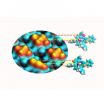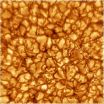(Press-News.org) The mechanism for binding oxygen to metalloporphyrins is a vital process for oxygen-breathing organisms. Understanding how small gas molecules are chemically bound to the metal complex is also important in catalysis or the implementation of chemical sensors. When investigating these binding mechanisms, scientists use porphyrin rings with a central cobalt or iron atom. They coat a copper or silver support surface with these substances.
An important characteristic of porphyrins is their conformational flexibility. Recent research has shown that each specific geometric configuration of the metalloporphyrins has a distinct influence on their functionality. In line with the current state of research, the scientists expected only a single CO molecule to bind axially to the central metallic atom. However, detailed scanning tunnel microscopy experiments by Knud Seifert revealed that, in fact, two gas molecules dock between the central metallic atom and the two opposite nitrogen atoms. Decisive is the saddle shape of the porphyrin molecules, in which the gas molecules assume the position of the rider.
The significance of the saddle geometry became apparent in model calculations done by Marie-Laure Bocquet from the University of Lyon. Her analysis helped the researchers understand the novel binding mode in detail. She also showed that the shape of the molecular saddle remains practically unchanged, even after the two gas molecules bind to the porphyrin.
The porphyrins reacted very differently when the researchers replaced the carbon monoxide with stronger-binding nitrogen monoxide. As expected, this binds directly to the central atom, though only a single molecule fits in each porphyrin ring. This has a significant effect on the electronic structure of the carrier molecule, and the characteristic saddle becomes flattened. Thus, the porphyrin reacts very differently to different kinds of gas – a result that is relevant for potential applications, such as sensors.
Dr. Willi Auwaerter, one of the authors, is thrilled: "What's new is that we actually saw, for the first time, the mechanism on a molecular level. We even can selectively move individual gas molecules from one porphyrin to another." The team aims to explain the physical and chemical processes on surfaces and in nanostructures. Once these fundamental questions are answered, they will take on new challenges: How big is the influence of the central atom? How does the binding change in planar conformations? How can such systems be utilized to implement catalyzers and sensors through controlled charge transfers?
INFORMATION:
The research was funded by the Deutsche Forschungsgemeinschaft (Cluster of Excellence "Munich Center for Advanced Photonics"), the TUM Institute for Advanced Study, the European Research Council (ERC Advanced Grant MolArt), as well as the Spanish Ministerio de Ciencia E Innovacion. The Leibniz Rechenzentrum of the Bayerische Akademie der Wissenschaften provided computing time. The research group of Professor Barth is member of the Catalysis Research Center (CRC) of the TUM.
Cis-dicarbonyl binding at cobalt and iron porphyrins with saddle-shape conformation, Knud Seufert, Marie-Laure Bocquet, Willi Auwärter, Alexander Weber-Bargioni, Joachim Reichert, Nicolás Lorente und Johannes V. Barth, Nature Chemistry, Online 9. January 2011 – DOI: 10.1038/NCHEM.956
Link: http://www.nature.com/nchem/journal/vaop/ncurrent/full/nchem.956.html
Further publications on this topic:
Discriminative Response of Surface-Confined Metalloporphyrin Molecules to Carbon and Nitrogen Monoxide, Knud Seufert, Willi Auwaerter und Johannes V. Barth, Journal of the American Chemical Society, 2010, 132, 18141� – DOI: 10.1021/ja1054884
Link: http://pubs.acs.org/doi/abs/10.1021/ja1054884
Direct observation of carbon monoxide binding to metal-porphyrines
New insights from the nano world
2011-01-11
ELSE PRESS RELEASES FROM THIS DATE:
Study finds nearly half of school social workers feel unequipped to handle cyberbullying
2011-01-11
Instances of cyber bullying continue to make news nearly every day, and while it's recognized as a problem among most school-aged children, a new study published this month in Children & Schools and coauthored by Temple University social work professor Jonathan Singer finds that nearly half of school social workers feel they are ill equipped to handle it.
"School social workers provide more crisis intervention services than any other school staff member – more than counselors, nurses, teachers, or psychologists," said Singer. "As a result, school social workers are a ...
'Liquid pistons' could drive new advances in camera lenses and drug delivery
2011-01-11
VIDEO:
Researchers at Rensselaer Polytechnic Institute have developed liquid pistons, which can be used to precisely pump small volumes of liquid. Comprising the pistons are droplets of nanoparticle-infused ferrofluids, which can...
Click here for more information.
Troy, N.Y. – A few unassuming drops of liquid locked in a very precise game of "follow the leader" could one day be found in mobile phone cameras, medical imaging equipment, implantable drug delivery devices, ...
Embryonic stem cells help deliver 'good genes' in a model of inherited blood disorder
2011-01-11
Researchers at Nationwide Children's Hospital report a gene therapy strategy that improves the condition of a mouse model of an inherited blood disorder, Beta Thalassemia. The gene correction involves using unfertilized eggs from afflicted mice to produce a batch of embryonic stem cell lines. Some of these stem cell lines do not inherit the disease gene and can thus be used for transplantation-based treatments of the same mice. Findings could hold promise for a new treatment strategy for autosomal dominant diseases like certain forms of Beta Thalassemia, tuberous sclerosis ...
An earlier start on diagnosing breast, prostate cancers
2011-01-11
Using biological samples taken from patients and state-of-the-art biochemical techniques, a Florida State University researcher is working to identify a variety of "biomarkers" that might provide earlier warnings of the presence of breast and prostate cancers.
"Biomarkers are indicators of certain biological and pathological processes that are occurring, such as cancer," said Qing-Xiang "Amy" Sang, a professor in Florida State's Department of Chemistry and Biochemistry. "Either the cancer cells themselves, or surrounding normal tissue for that matter, can produce specific ...
Protein thought to protect against oxidative stress also promotes clogging of arteries
2011-01-11
UCLA researchers have found that a protein that plays an important role in some antioxidant therapies may not be as effective due to additional mechanisms that cause it to promote atherosclerosis, or clogging of the arteries.
Published in the January issue of the journal Arteriosclerosis, Thrombosis and Vascular Biology, the finding may give clues as to why some antioxidant therapies have not yielded more positive results.
The protein, called Nrf2, has been thought to be an important drug-therapy target for diseases such as cancer because it can induce chemopreventive ...
New species of flying reptile identified on B.C. coast
2011-01-11
Persistence paid off for a University of Alberta paleontology researcher, who after months of pondering the origins of a fossilized jaw bone, finally identified it as a new species of pterosaur, a flying reptile that lived 70 million years ago.
Victoria Arbour says she was stumped when the small piece of jaw bone was first pulled out of of a fossil storage cabinet in the U of A's paleontology department.
"It could have been from a dinosaur, a fish or a marine reptile," said Arbour. "
Arbour, a PhD student in paleontology, says the first clue to the fossil's identify ...
New glass tops steel in strength and toughness
2011-01-11
Glass stronger and tougher than steel? A new type of damage-tolerant metallic glass, demonstrating a strength and toughness beyond that of any known material, has been developed and tested by a collaboration of researchers with the U.S. Department of Energy (DOE)'s Lawrence Berkeley National Laboratory (Berkeley Lab)and the California Institute of Technology. What's more, even better versions of this new glass may be on the way.
"These results mark the first use of a new strategy for metallic glass fabrication and we believe we can use it to make glass that will be even ...
How do you make lithium melt in the cold?
2011-01-11
Washington, D.C. — Sophisticated tools allow scientists to subject the basic elements of matter to conditions drastic enough to modify their behavior. By doing this, they can expand our understanding of matter. A research team including three Carnegie scientists was able to demonstrate surprising properties of the element lithium under intense pressure and low temperatures. Their results were published Jan. 9 on the Nature Physics website.
Lithium is the first metal in the periodic table and is the least dense solid element at room temperature. It is most commonly known ...
First strawberry genome sequence promises better berries
2011-01-11
DURHAM, N.H. – An international team of researchers, including several from the University of New Hampshire, have completed the first DNA sequence of any strawberry plant, giving breeders much-needed tools to create tastier, healthier strawberries. Tom Davis, professor of biological sciences at UNH, and postdoctoral researcher Bo Liu were significant contributors to the genome sequence of the woodland strawberry, which was published last month in the journal Nature Genetics.
"We now have a resource for everybody who's interested in strawberry genetics. We can answer questions ...
New insights into sun's photosphere reported by NJIT researcher at Big Bear
2011-01-11
NJIT Distinguished Professor Philip R. Goode and the research team at Big Bear Solar Observatory (BBSO) have reported new insights into the small-scale dynamics of the Sun's photosphere. The observations were made during a period of historic inactivity on the Sun and reported in The Astrophysical Journal . http://iopscience.iop.org/2041-8205/714/1/L31 The high-resolution capabilities of BBSO's new 1.6-meter aperture solar telescope have made such work possible.
"The smallest scale photospheric magnetic field seems to come in isolated points in the dark intergranular ...
LAST 30 PRESS RELEASES:
Sleeping in on weekends may help boost teens’ mental health
Study: Teens use cellphones for an hour a day at school
After more than two years of war, Palestinian children are hungry, denied education and “like the living dead”
The untold story of life with Prader-Willi syndrome - according to the siblings who live it
How the parasite that ‘gave up sex’ found more hosts – and why its victory won’t last
When is it time to jump? The boiling frog problem of AI use in physics education
Twitter data reveals partisan divide in understanding why pollen season's getting worse
AI is quick but risky for updating old software
Revolutionizing biosecurity: new multi-omics framework to transform invasive species management
From ancient herb to modern medicine: new review unveils the multi-targeted healing potential of Borago officinalis
Building a global scientific community: Biological Diversity Journal announces dual recruitment of Editorial Board and Youth Editorial Board members
Microbes that break down antibiotics help protect ecosystems under drug pollution
Smart biochar that remembers pollutants offers a new way to clean water and recycle biomass
Rice genes matter more than domestication in shaping plant microbiomes
Ticking time bomb: Some farmers report as many as 70 tick encounters over a 6-month period
Turning garden and crop waste into plastics
Scientists discover ‘platypus galaxies’ in the early universe
Seeing thyroid cancer in a new light: when AI meets label-free imaging in the operating room
Neutrophil-to-lymphocyte ratio may aid risk stratification in depressive disorder
2026 Seismological Society of America Annual Meeting
AI-powered ECG analysis offers promising path for early detection of chronic obstructive pulmonary disease, says Mount Sinai researchers
GIMM uncovers flaws in lab-grown heart cells and paves the way for improved treatments
Cracking the evolutionary code of sleep
Medications could help the aging brain cope with surgery, memory impairment
Back pain linked to worse sleep years later in men over 65, according to study
CDC urges ‘shared decision-making’ on some childhood vaccines; many unclear about what that means
New research finds that an ‘equal treatment’ approach to economic opportunity advertising can backfire
Researchers create shape-shifting, self-navigating microparticles
Science army mobilizes to map US soil microbiome
Researchers develop new tools to turn grain crops into biosensors
[Press-News.org] Direct observation of carbon monoxide binding to metal-porphyrinesNew insights from the nano world




